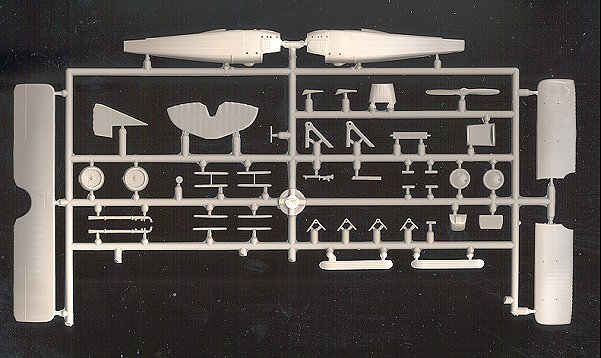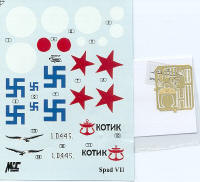
|
KIT: |
Mac 1/72 Dux Spad |
|
KIT # |
72050 |
|
PRICE: |
$18.48 (16.46 at Squadron) |
|
DECALS: |
four options |
|
REVIEWER: |
Scott Van Aken |
|
NOTES: |

|
HISTORY |
French aero engines during the early years of the WWI seemed to settle on the rotary, a type that was simple, offered good power and was reliable. However, there were drawbacks with the type in that there was a definite limitation on the power available and there was the incredible torque reaction provided by the basic engine design. In early 1915 a light weight water cooled V-8 was developed that had a major impact on French and Allied aero engine design.
In late 1915 S.P.A.D. developed a single-seat biplane around the 140 Hispano-Suiza V-8. This design was developed as engine power was increased to 200hp and the SPAD VII fighter finally reached the front in late 1916. It quickly became popular, not only for its power, but also for its robust construction. Piloted by such luminaries as Fonch and Guynemer, the pilots of Esc 3 soon gained local ascendancy over the German planes. These were definitely an improvement over the current crop of Nieuports. Probably its only weakness was that it was still a single gun fighter. The other Allies and the Germans used twin gun planes for a considerable period before the French finally brought out the two gun Spad XIII in early 1918.
Despite being over-gunned, superior tactics and the ability to dive at high speeds without losing wings made the Spad VII a very popular aircraft. Not only with the French but with other Allies such as the Italians and Russians. It was in use by the Lafayette Escadrille when it finally became the 103rd Aero Squadron in 1918. Spad VIIs were used by a wide number of countries post war, including the US, Finland, Russia, Poland, Spain, Czechoslovakia, and Japan.
Thanks to those readers who wrote in to tell me that DUX was a Russian company that made Spad VIIs for Russia and Finland.
|
THE KIT |

Molded in tan on a single sprue that barely fits the box, the MAC kit seems to be a major improvement over the only other readily available Spad VII previously done; that one from Airfix. The detailing is well done, if not a touch on the soft side. Flight surface ribbing is quite subdued and the fuselage isn't bad either. There are no problems with ejector pin marks/towers nor with sink areas or flash. Some parts have a bit more mold seam than others, but nothing major.
As a simple kit, there are not that many parts. Interior is quite small and a combination of etched parts and plastic allow for it to be well detailed. There are optional parts for the radiator and windscreen. Also included are some skis for a couple of the options. One can pretty well figure out what goes where, though. Etched brass is provided for several interior components, including a seat harness and for some strut braces and a steps. Instructions are well done with clear construction sequences and they provide color information where applicable. A rigging diagram is also provided, but it would be much better if it filled a larger space so it would be easier to see. There is plenty of white space on the page for this to be done.
 You
are probably having a bit of deja vu if you have read the description of
the other two MAC Spad VIIs. That is because the plastic is exactly the
same in all three kits.
You
are probably having a bit of deja vu if you have read the description of
the other two MAC Spad VIIs. That is because the plastic is exactly the
same in all three kits.
Over half the instructions are given to three views as well as painting and decal placement guides. Markings are provided for four aircraft, though it doesn't seem like it from looking at the sheet. Well, the first is the box art plane from Finland in 1918, complete with skis. The other three are from various Russian units in basically linen with the forward sections being in light grey. The first one has a black fin and rudder with a white circle in it and an eagle marking on the side.. The second has a white rudder with a red circle in it and a naval marking on the side. The third is a totally non-descript aircraft on skis. Decals look to be nice and thin and should work well since they go over a solid color.
|
CONCLUSIONS |
Those who have built the other kits have had no real problems with them and they will make a very nice change to the ancient Airfix kit.
You can find this kit and many others at

If you would like your product reviewed fairly and fairly quickly by a site that has over 250,000 visitors a month, please contact me or see other details in the Note to Contributors.